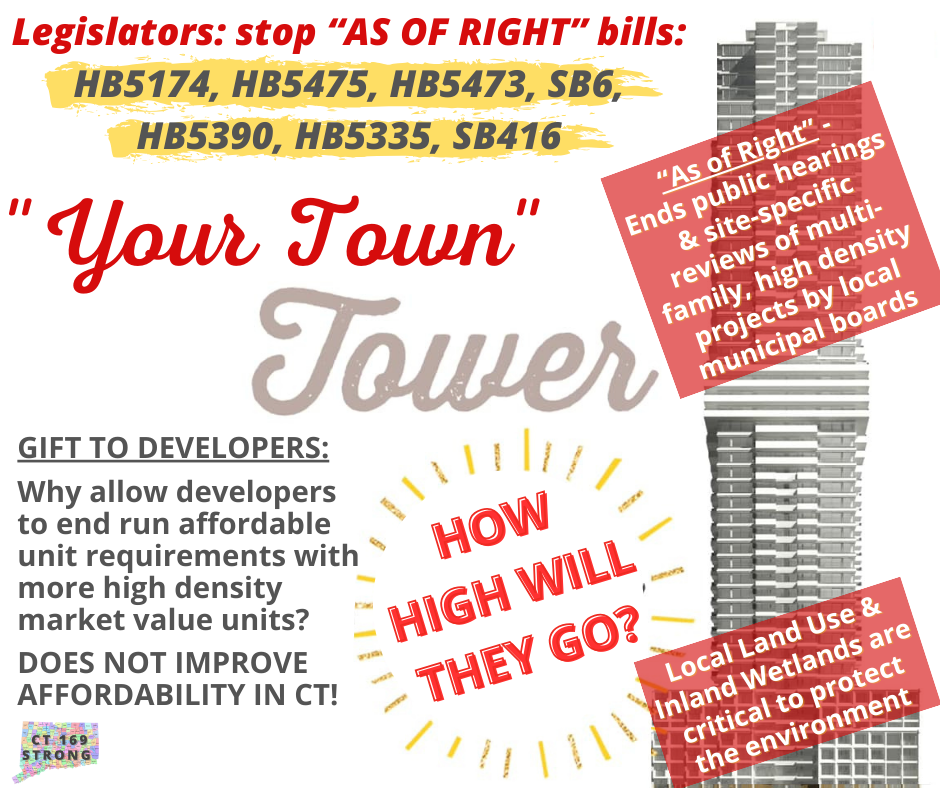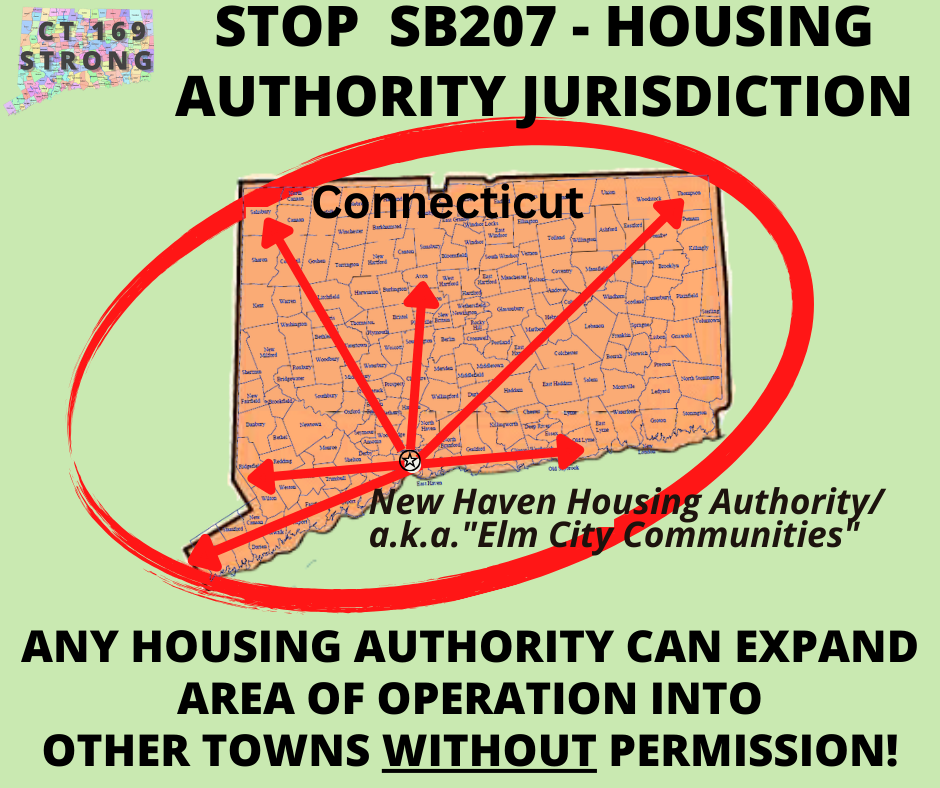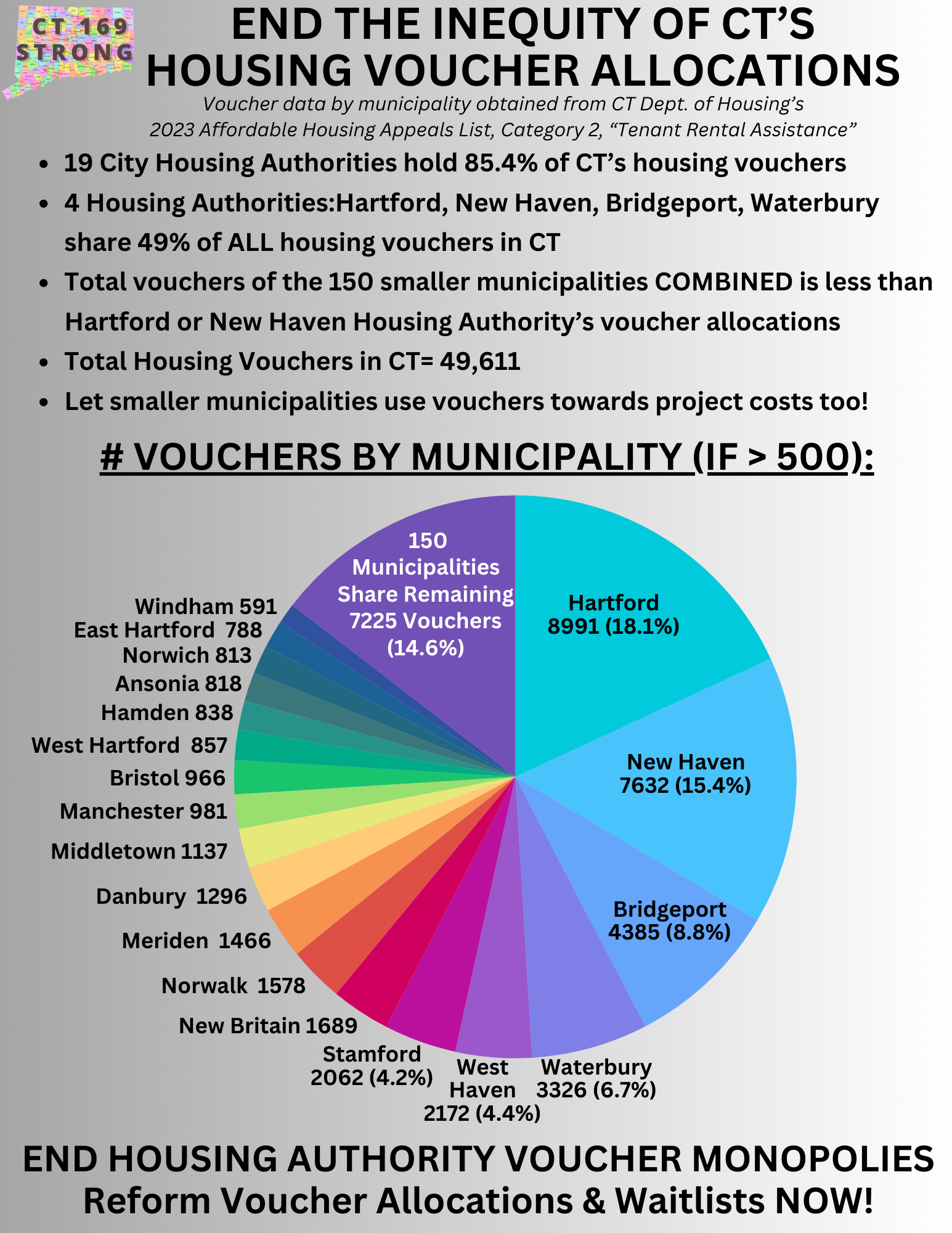2024 BAD BILLS WE ARE TRACKING AND FIGHTING
Legislators Want to End Single Family Zoning in Connecticut!

Central planners are going to tell you how to live and where to live whether you are in a city, suburb or rural community. The intention of legislators and bureaucrats is to mandate towns to fund development themselves, or have court intervention to force dense “as of right” market value multifamily development everywhere and end single family zoning in CT forever. These bills were never about creating true affordability. In addition, only 50% of housing vouchers are currently utilized in CT. Majority legislators refuse to pass meaningful housing voucher reforms to centralize waitlists, to centralize voucher allocations, to increase portability of vouchers and end the big city housing authority monopolies on housing vouchers.
The Proposed Bad Zoning bills will:
• Turn every suburban downtown into a small city, regardless of inadequate infrastructure, environment, historical areas, access to affordable mass public transportation and availability of jobs.
• Make no consideration of what exponential overdevelopment of housing stock with high rise apartments in downtowns would do, potentially creating greater congestion, stormwater runoff and pollution.

Connecticut has the second highest property taxes in the nation and the third highest utility costs (the highest electricity costs). CT’s residents scrimp, save and make great sacrifices when choosing to live in a specific neighborhood, and for most people, their homes represent their largest asset. Proposals that create over-densification with “as of right” 80-90% market value multifamily (mostly rentals) development are nothing but a gift to predatory developers and actually will diminish affordability and greatly impact local economic stability. These policies will cause more outmigration if CT’s underlying economic concerns and overall affordability is not addressed.
Multiple hive-minded housing advocacy groups like DesegregateCT, backed by developer funded Regional Planning Associates (RPA) have sprung onto the lobbying scene in Hartford with one orchestrated script, creating the illusion of many different voices but in reality are all inter-connected.

Bureaucrats’ “carrots” require municipalities to implement zones with “as-of” right multifamily development that can neve be reversed.
• Limiting entirely or severely restricting off-street parking requirements would cause inadequate parking for both residents and small local businesses.
• Coastal flooding and climate change resiliency and sustainability planning are largely ignored, as the bills would pack dense populations especially into coastal downtown areas that are most exposed to flooding. One size, top-down state mandates do not recognize the unique aspects of each of the 169 municipalities in CT. Responsible zoning decisions are best made by locally-elected officials, who are held accountable for establishing regulations that are faithful to the town’s Plan of Conservation and Development and who transparently apply those regulations without any favor or bias. Zoning is truly color blind.

STATEMENT FROM CT169STRONG ON THE 2023 PASSAGE OF FAIR SHARE PHASE 1
CT169 Strong is a non-partisan group dedicated to local zoning control to ensure thoughtful and appropriate development of our communities through prudent land use decision making. We are thankful to the many supporters and especially to the Democrat and Republican legislators who rejected the burdensome and poorly crafted “top down” zoning bills that were introduced to the House. We continue to fight for policies that work and make Connecticut better – and demand effective reforms that create true affordability, not just density.
Last night, the Senate voted to pass SB 998, which had been amended in a late night session of the House to add several provisions from the failed and rejected “Fair Share” bill. These provisions include empowering the Office Of Policy and Management (OPM) and an expanded Office of Responsible Growth to establish a methodology and to allocate “affordable” housing development quotas to the towns and cities of our State, at up to 20% of each municipality’s total housing stock. The bill also sets up several high level housing development advisory groups that exclude any environmental or climate change stakeholders or experts, and has only token zoning participation.
While the mandatory development portions of Fair Share were not added to SB 998, the bill language legitimizes the reckless and unworkable methodology proposed by the housing advocates of Open Communities Alliance (OCA). The very same bill language in SB998 failed to pass in the two prior legislative sessions when the extremely high fair share numbers for every municipality were disclosed. This session, the bill’s proponents did not disclose the actual Fair Share numbers of each municipality, but SB998 has set up the bureaucratic structure to impose extreme development mandates without regard to local capacities, constraints or needs, and without consideration of environmental issues, or open space and historic resource preservation.
We are hopeful that Governor Lamont, who supports local control over land use decisions, will reaffirm his commitment to municipalities throughout the state against this ill conceived scheme and veto SB 998 given that it sets up overburdened taxpayers to pay $20 billion in new taxes and it will be the largest unfunded mandate in our State’s history. Make no mistake, this one bill dwarfs any tax relief he has achieved thus far. For the average resident, more than 90 percent of their wealth is tied up in their homes.
Appropriate development, growth and positive change are best achieved through long standing beneficial zoning and regulatory practices. This ensures that changes in land use and our natural environment are done in a thoughtful, considered, fair and equitable manner that encourages public participation by all residents.
However, each year the same bills are introduced by well funded housing development groups, some backed by out of state development interests, which do little more than erode zoning for the benefit of developers and corporate real estate interests. These lobbying efforts have resulted in multiple bills proposed over the past several years intended to usurp the authority of local planning and zoning commissions, eliminate public hearings and silence public voices, degrade environmental protections, override local concerns and impose central planning by unaccountable State officials.
The bills seek to destroy local decision-making and replace it with top down “as of right” development, thereby shredding any notion of thoughtful land use planning in both large cities and small towns, and severely impairing the ability of towns and ultimately the State to ensure protection of its open space and natural resources.
There has been significant bipartisan opposition to most of these anti-zoning bills, including Fair Share and SB 988, in both the House and Senate, as well as by municipal officials and state residents, and for good reason: centralized planning does not work in land use decision making.
Residents from around the state, as well as local and state officials have recognized these legislative threats to the ability to plan and manage the orderly and optimal development of each of our 169 municipalities.
CT169Strong has received enormous positive feedback and tangible support, which far exceeded our expectations. It is clear that the residents of Connecticut want common sense, well founded solutions achieved through a process that emphasizes inclusion, transparency and a true diversity of stakeholders. We are thankful for this outpouring of support for our mission, and will continue to work towards development initiatives that are in the best long term interests of our State.
GOOD BILLS WE SUPPORT
CT169Strong IN THE NEWS
The Passage of Fair Share Phase 1 and What it Means for Connecticut Residents
Despite bipartisan opposition, a majority of the Connecticut House and Senate passed SB-998, a bill that brings the “Fair Share” Housing Model to Connecticut. Fair Share is a controversial legislative[…]
Read moreRats Subvert Connecticut’s Democratic Process
There has been an ugly infestation of rats in Connecticut – not the small furry rodents – but rather sneaky pieces of legislation that get written into bills at the[…]
Read moreTransit-Oriented Development Bill Lacks Local Input, Environmental Provisions
To the Editor: I recently had the opportunity to share my thoughts on HB 5390, An Act Concerning Transit-Oriented Communities and my opposition to pieces of the legislation. There have[…]
Read moreNegating Local Zoning Won’t Solve the High Cost of Renting and Buying
To the Editor: A recent story on the debate in the public hearing on Senate Bill 6 repeated without attribution the trope that: “Connecticut lacks about 92,500 units of housing[…]
Read more

